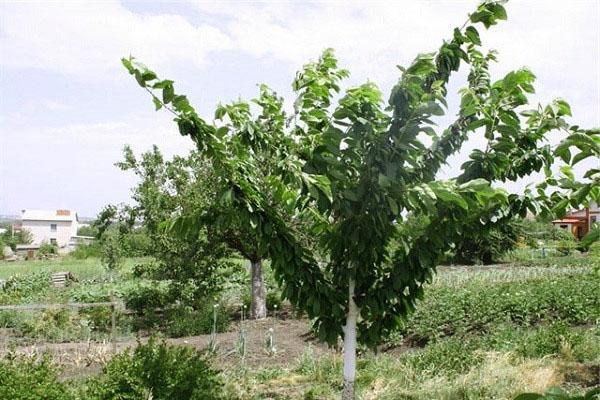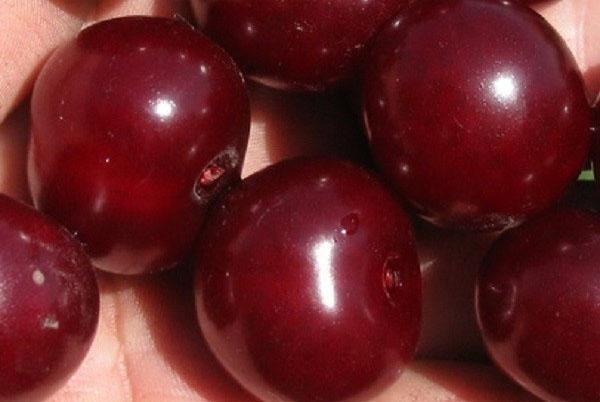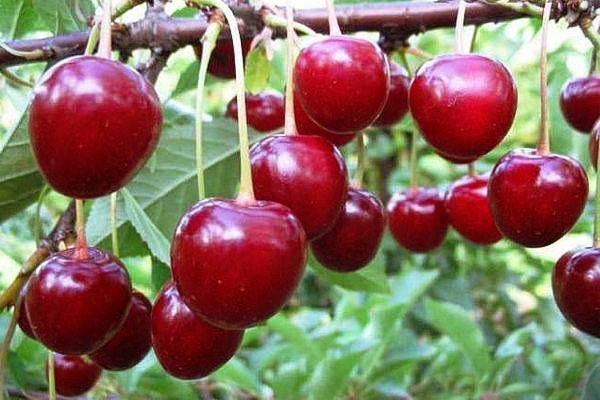Sweet berry - Turgenevka cherry
 Cherry variety Turgenevka, or as it is also called Turgenevskaya, was bred in 1979. The parent variety was Zhukovskaya cherry. The main advantage of Turgenevka is its frost resistance, although, like all fruit trees, it reacts poorly to frost during the flowering period and sudden temperature changes. It should also be remembered that the harvest can only be obtained in the fifth year of planting. In general, the variety has proven itself well and is widely used for mass cultivation in gardens (see. cherry chocolate variety description with photo).
Cherry variety Turgenevka, or as it is also called Turgenevskaya, was bred in 1979. The parent variety was Zhukovskaya cherry. The main advantage of Turgenevka is its frost resistance, although, like all fruit trees, it reacts poorly to frost during the flowering period and sudden temperature changes. It should also be remembered that the harvest can only be obtained in the fifth year of planting. In general, the variety has proven itself well and is widely used for mass cultivation in gardens (see. cherry chocolate variety description with photo).
Description of the variety and photo of Turgenevka cherries
Cherry has an average height (no more than 3 meters), the crown is formed according to the principle of an inverted pyramid with not very dense branches. By the fifth year of the tree's life, the crown diameter can be 1 meter. The trunk itself and the main branches are brown with a gray tint, and the young shoots are brown.
It was noticed that the cone-shaped buds of Turgenevka cherries move away from the shoot. They reach 0.5 cm in length. Cherry leaf - dark green with a glossy shade, elongated on both sides, resembling a boat in shape.
As mentioned above, cherries begin to bear fruit from the fifth year after planting the tree, and with proper care they can live for 25 years. The harvest from one young tree reaches 10 kg, and an adult cherry is capable of producing up to 25 kg of berries.
Turgenev cherry blossoms in the second decade of May, has inflorescences of 4 flowers with white petals. Cherries begin to ripen in early July. The berries grow in tassels of four deep red cherries, a bit like a heart in shape. The petioles are 2 cm long. Large fruits (weighing up to 5 g) are sweet in taste, they sour quite a bit. The stone is separated well, and by weight it is only 8% of the weight of the fruit (0.4 g). Thanks to this, Turgenevka gained her recognition in the field of culinary. But keep in mind that if you pick the cherries before they are fully ripe, they will be sour.
Among the descriptions of the advantages of Turgenevka cherries, they highlight its good:
- yield;
- frost resistance;
- resistance to disease.
A selection of photos of Turgenevka cherries:





Selection and planting of varietal cherry seedlings
In order not to regret the wasted time and spent finances in the future, which is especially important when purchasing one variety in bulk, when choosing a seedling for planting, you must very carefully examine it for belonging to the desired variety. It is worth considering that an annual cherry sapling will have the following dimensions:
- the length of the root system is at least 20 cm;
- trunk circumference - from 10 to 12 cm;
- the total height of the seedling is at least one meter.
 No less attention should be paid to the roots and twigs - they must be intact and alive.
No less attention should be paid to the roots and twigs - they must be intact and alive.
Cherry variety Turgenevka needs pollinators, since it belongs to partially self-fertile varieties. Best of all will cope with this task cherry varieties Molodezhny, Lyubsky, Favorite, Melitopol joy. When planting trees, the distance between the pollinated varieties should be no more than 40 meters. In this area, other trees should not be planted between varieties so that they are not cross-pollinated.
 In the case when it is not possible to grow a pollinator next to it, its branch can be grafted onto the Turgenev cherry. The graft is done on the crown.If the grafted branch has not taken root, as an option, bowls of water are placed around the Turgenevka cherry, in which flowering shoots of the pollinator should be placed.
In the case when it is not possible to grow a pollinator next to it, its branch can be grafted onto the Turgenev cherry. The graft is done on the crown.If the grafted branch has not taken root, as an option, bowls of water are placed around the Turgenevka cherry, in which flowering shoots of the pollinator should be placed.
 Planting and caring for Turgenevskaya cherries practically do not differ from the recommendations for other varieties of cherries. Turgenevka is planted in the spring. When laying a garden, seedlings are planted at a distance of 2 meters from each other. When choosing a planting site, they are guided by the fact that cherries like good lighting and are afraid of drafts, high humidity and soil acidity.
Planting and caring for Turgenevskaya cherries practically do not differ from the recommendations for other varieties of cherries. Turgenevka is planted in the spring. When laying a garden, seedlings are planted at a distance of 2 meters from each other. When choosing a planting site, they are guided by the fact that cherries like good lighting and are afraid of drafts, high humidity and soil acidity.
Seedlings are taken no older than two years, since an increase in the age of a seedling negatively affects its survival rate.
Planting a seedling is as follows. Dig a planting hole 85 cm wide and 45 cm deep. The soil from the pit is mixed with humus (1 bucket), wood ash (400 g), superphosphate (200 g) and potash fertilizer (50 g). Acidic soil must be limed (200 g per pit), and clay soil must be diluted with sand (1 bucket). Place a seedling in the hole, spread the roots and cover with earth, leaving the root collar above ground level.
 To prevent the water from spreading during watering, fold a side of the soil around the tree. Next, water the seedling well and lay mulch around (peat or humus). To create support, place a peg next to the seedling and tie it up.
To prevent the water from spreading during watering, fold a side of the soil around the tree. Next, water the seedling well and lay mulch around (peat or humus). To create support, place a peg next to the seedling and tie it up.
Young cherry care
The basis for caring for young plantings is their watering... It should be regular and abundant, but at the same time it is important to prevent stagnation of water, as this will lead to decay of the roots. Therefore, it should be watered as the top layer of the soil dries out.
 As the tree grows, it is necessary to expand the near-stem circle, which, after watering, must be loosened and mulched. This is done so that a crust does not form on the ground, which prevents air from reaching the root system, and also so that weeds do not grow, which will take useful elements from the seedling and drown out its further growth. With the arrival of autumn, carefully dig up the soil around the seedlings.
As the tree grows, it is necessary to expand the near-stem circle, which, after watering, must be loosened and mulched. This is done so that a crust does not form on the ground, which prevents air from reaching the root system, and also so that weeds do not grow, which will take useful elements from the seedling and drown out its further growth. With the arrival of autumn, carefully dig up the soil around the seedlings.
To enrich the soil with nitrogen and stimulate active tree growth between plantings, it is recommended to sow leguminous crops (peas, beans) or alfalfa. In this case, leave the trunk circle unseeded.
By the second year of life, the seedling should grow by 60 cm.If this did not happen, during autumn digging, fertilize the cherry with a mixture of 1 bucket of humus and 100 g of double superphosphate. In the spring, feed the tree with a mixture of ammonium nitrate (20 g), double superphosphate (10 g) and potassium salts (5 g).
Every three years cherries are fed with humus.
Spring pruning of a grown seedling
In the spring of a grown tree, cut off all dry branches and form a crown - cut out the shoots that go inside the crown. Treat the cuts with garden pitch.
In addition to spring, there is also summer pruning of cherries. It involves the removal of root growth, which takes strength from the seedling.
Protection against pests and diseases of cherries
Most often, the tree is damaged by such cherry pests:
- mole;
- slime sawfly larvae;
- aphid;
- weevil;
- caterpillars of the ringed silkworm.
If they are found, treat the tree with special preparations.
Among cherry diseases, key places are occupied by:
- Coccomycosis manifests itself as a lesion in the form of rust on the leaves and young branches, leading to their drying out and dropping.
- Hole spotting causes the death of foliage and inflorescences.
- Gum cutting - drying of shoots.
- Gray mold affects fruits.
- Moniliosis causes growths on the branches and fruit rot.
To prevent diseases and protect against pests and various diseases, treat cherries twice a year (in spring - with the appearance of buds and in summer - after flowering) with a solution containing an insecticide and a fungicide. In addition, Bordeaux liquid is used every year for this purpose, and every three years - 3% Nitrofen solution.
In addition to the cherry pests described above, birds love to feast on fruits.To protect the crop from them, a net should be pulled over the tree.